Yeast Viability- Looking at Expired Yeast
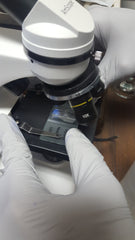
For a long time I've been wanting to look at yeast from various labs to see what exactly is in the package. Every lab makes claims as to cell count and viability over time. Brewing software will tell you how many cells should be in a pack after x amount of time, and then nearly every brewer has some anecdotal opinion regarding the same, but how accurate is any of this? Since, for example, White Labs developed the PurePitch packaging for yeast, these estimations are no longer accurate for this lab. They have extended the best by date on their packs from 4 months from date of manufacture to 6 months, citing better yeast health and viability as the reason. Additionally, the membranes are specially designed to allow CO2 buildup to diffuse out instead of putting excess pressure on the yeast. The supposed result is that even after 6 months, the yeast is still at approximately 70% viability! That's insane for liquid yeast. This all sounds great, but do any of these claims hold up?
As I'd been thinking heavily about all of this, I found that I had two packs of expired yeast from two different labs- Wyeast and White Labs. Not only that, but they had the same manufacture date- August 16th, 2017, which was 7.5 months old. According to brewers' opinions and brewing calculators, all of the yeast should be dead in these packs. According to White Labs, their pack should still be at somewhere north of 50% viable. It should be noted that these were different strains of yeast used in this exercise- Wyeast 2565 Kolsch and WLP351 Bavarian Weizen.

I contacted Tom Micelli at Whistle Hop Brewing in Fairview, NC to see if he'd be interested in looking at yeast with me. I hoped the answer would be Yes, as it was his lab I needed to use! Tom was thrilled to geek out on cells, so we got together to plate and scope the yeast. The results were absolutely shocking to both of us.

Measuring out yeast slurry.

Prepping the methylene violet solution.

Adding the dye to the diluted slurry before plating.

Injecting the dyed yeast into the hemocytometer.

In the last image, we've got the microscope adjusted over the hemocytometer and we're counting the dead cells. Living cells are able to metabolize the dye and excrete it, so they look clear. Dead cells, on the other hand, are dead and cannot metabolize anything, so they absorb the dye.
Tom's program allows us to count the number of cells in each grid block, which then gives us a total cell count per mL. This, however, is not that useful if all of your yeast is dead, so we then count the dead cells in the blocks, enter those figures, and the magic of software presents us with total viability (viability being the percentage of living cells in a sample). With that, we can then know how much yeast slurry to pitch in any given beer.
The results?
Here is an expanded view of the Wyeast sample (A) and White Labs sample (B)
(A)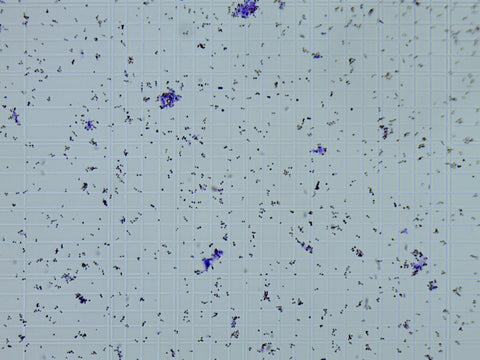
and here's
(B)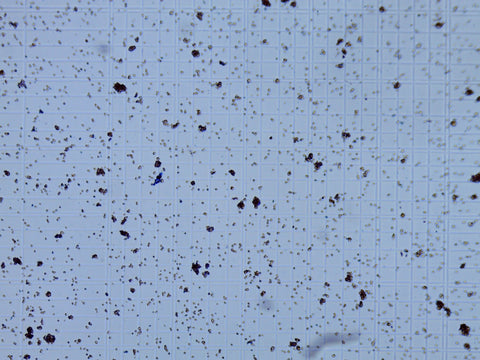
It's immediately apparent that the Wyeast is mostly dead, whereas the White Labs appears to be mostly alive. Now let's look at a couple zoomed in images from our actual cell counting. Again, image (A) is Wyeast and (B) is White Labs.
(A)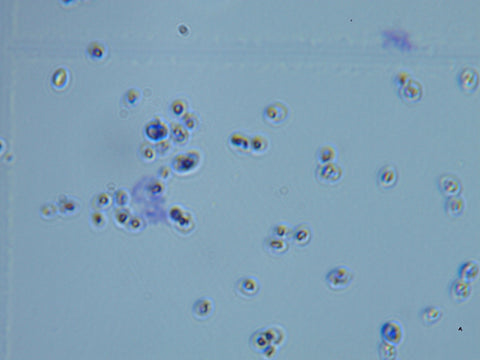
and then
(B)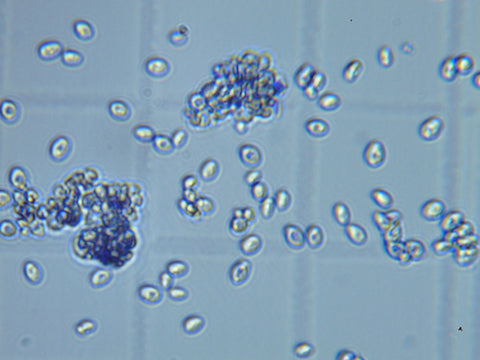
See the difference!? The Wyeast has only a few living cells, whereas it was difficult to find dead ones on the White Labs plate. On the latter plate, we could even see cells moving around and some budding occurring! No such activity was witnessed on the Wyeast plate.
Now if you're wondering about the clumps, some clumping is normal and doesn't factor into the cell counts. You can see in the expanded view that both samples had some clumps. When counting, you try to avoid excessively clumped areas since it's hard to count the cells present, let alone tell if the cells are alive or dead. In the zoomed in White Labs image, the clumps were not counted, though even they look largely alive.
So even from a cursory glance, we could tell which lab's yeast was more viable, but the question was how viable. Viability is what matters at the end of the day, not whether a lab says there are 100 billion cells or 200 billion if you don't know how many are dead. After doing our counts, the computer gave us the results:
Wyeast was 4% viable
White Labs was 92% viable
This was what was to be expected from Wyeast, but the White Labs figure was truly shocking. I can now say with total confidence that a pack of White Labs yeast that is at or even beyond its best by date is still very pitchable. It's also very easy to go to the White Labs website look up the exact cell count on any pack of yeast using the lot number printed on the package. So if your yeast is at the best by date (6 months old), you can look up the cell count at packaging and comfortably assume 70% viability as they claim. The actual viability, as we saw, may be a good deal higher however!
Cheers and happy ferments!
-Tedd
- Theodore Clevenger


Comments 0